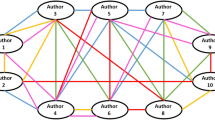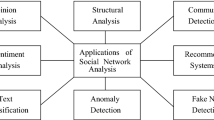Abstract
The rapid development of online social networks such as Reddit, Twitter, Facebook, and so on are widely expanded. The anomaly detection plays an important role in social networks due to different kinds of malicious activities involving misleading crowdsourcing, contact lists, and spamming results with fake accounts. In this paper, Deep Belief Neural based Interactive Autodidactic School (DBN-IAS) algorithm is proposed to detect anomalies from social networks. Particularly, the novel IAS algorithm is used for optimization of optimal hidden layers from DBN. The experimental details are obtained from both benchmark and real-time datasets. Experimentally, the DBN-IAS approach is compared with other existing methods such as GCN, RBM + SVM with SDN, and LAD. Finally, the DBN-IAS algorithm demonstrated optimal anomaly detection results from social networks and the proposed algorithm shows the detection rate of 99.32%, which is far better than the existing approaches.










Similar content being viewed by others
References
Alrawashdeh K, Purdy C (2016) Toward an online anomaly intrusion detection system based on deep learning. In: 2016 15th IEEE international conference on machine learning and applications (ICMLA), pp. 195–200, IEEE. https://doi.org/10.1109/ICMLA.2016.0040
Cheng Q, Zhou Y, Feng Y, Liu Z (2020) An unsupervised ensemble framework for node anomaly behavior detection in social network. Soft Comput 24(9):6421–6431
Chiba Z, Abghour N, Moussaid K, El Omri A, Rida M (2018) A novel architecture combined with optimal parameters for back propagation neural networks applied to anomaly network intrusion detection. ComputSecur 75:36–58
Chikh R, Chikhi S (2019) Clustered negative selection algorithm and fruit fly optimization for email spam detection. J Ambient Intell Human Comput 10:143–152. https://doi.org/10.1007/s12652-017-0621-2
Dadfarnia M, Adibnia F, Abadi M, Dorri A (2020) Incremental collusive fraud detection in large-scale online auction networks. J Supercomput 76:7416–7437. https://doi.org/10.1007/s11227-020-03170-9
Erfani SM, Rajasegarar S, Karunasekera S, Leckie C (2016) High-dimensional and large-scale anomaly detection using a linear one-class SVM with deep learning. Pattern Recogn 58:121–134
Gao N, Gao L, Gao Q, Wang H (2014) An intrusion detection model based on deep belief networks. In: 2014 Second international conference on advanced cloud and big data (pp 247–252), IEEE. https://doi.org/10.1109/CBD.2014.41
Garg S, Kaur K, Kumar N, Kaddoum G, Zomaya AY, Ranjan R (2019) A hybrid deep learning-based model for anomaly detection in cloud datacenter networks. IEEE Trans NetwServ Manage 16(3):924–935
Garg S, Kaur K, Kumar N, Rodrigues JJ (2019) Hybrid deep-learning-based anomaly detection scheme for suspicious flow detection in SDN: a social multimedia perspective. IEEE Trans Multimedia 21(3):566–578
Hassanzadeh R, Nayak R, Stebila D (2012) Analyzing the effectiveness of graph metrics for anomaly detection in online social networks. In: International conference on web information systems engineering (pp. 624–630), Springer, Berlin, Heidelberg. https://doi.org/10.1007/978-3-642-35063-4_45
Heard NA, Weston DJ, Platanioti K, Hand DJ (2010) Bayesian anomaly detection methods for social networks. Ann Appl Stat 4(2):645–662
Iamsumang C, Mosleh A, Modarres M (2015) Hybrid DBN monitoring and anomaly detection algorithms for on-line SHM. In: 2015 Annual Reliability and Maintainability Symposium (RAMS) (pp 1–7), IEEE. https://doi.org/10.1109/RAMS.2015.7105184
Jahangiri M, Hadianfard MA, Najafgholipour MA, Jahangiri M, Gerami MR (2020) Interactive autodidactic school: a new metaheuristic optimization algorithm for solving mathematical and structural design optimization problems. ComputStruct 235:106268. https://doi.org/10.1016/j.compstruc.2020.106268
Jiang J, Chen J, Gu T, Choo KKR, Liu C, Yu M, Mohapatra P (2019) Anomaly detection with graph convolutional networks for insider threat and fraud detection. In: MILCOM 2019–2019 IEEE military communications conference (MILCOM) (pp 109–114), IEEE. https://doi.org/10.1109/MILCOM47813.2019.9020760
Jose T, Babu SS (2019) Detecting spammers on social network through clustering technique. J Ambient Intell Human Comput. https://doi.org/10.1007/s12652-019-01541-6
Kaur R, Singh S (2017) A comparative analysis of structural graph metrics to identify anomalies in online social networks. ComputElectrEng 57:294–310
Liu B, Sun X, Ni Z, Cao J, Luo J, Liu B, Fu X (2020) Co-Detection of crowdturfing microblogs and spammers in online social networks. World Wide Web 23(1):573–607
Ma N, Wang S, Yu J, Peng Y (2017) A DBN based anomaly targets detector for HSI. In: AOPC 2017: 3D measurement technology for intelligent manufacturing (vol. 10458, p. 104581Z). International Society for Optics and Photonics. https://doi.org/10.1117/12.2285766
Savage D, Zhang X, Yu X, Chou P, Wang Q (2014) Anomaly detection in online social networks. SocNetw 39:62–70
Shone N, Ngoc TN, Phai VD, Shi Q (2018) A deep learning approach to network intrusion detection. IEEE Trans Emerg Top ComputIntell 2(1):41–50
Shrestha A, Serra E, Spezzano F (2020) Multi-modal social and psycho-linguistic embedding via recurrent neural networks to identify depressed users in online forums. NetMAHIB 9(1):22. https://doi.org/10.1007/s13721-020-0226-0
Viswanath B, Bashir MA, Crovella M, Guha S, Gummadi KP, Krishnamurthy B, Mislove A (2014) Towards detecting anomalous user behavior in online social networks. In: 23rd {USENIX} Security Symposium ({USENIX} Security 14) (pp 223–238). ISBN 978-1-931971-15-7
Wang J, Kuang Q, Duan S (2015) A new online anomaly learning and detection for large-scale service of internet of thing. PersUbiquitComput 19(7):1021–1031
Wu X (2019) A trust-based detection scheme to explore anomaly prevention in social networks. KnowlInfSyst 60(3):1565–1586
Wulsin D, Blanco J, Mani R, Litt B (2010) Semi-supervised anomaly detection for EEG waveforms using deep belief nets. In: 2010 Ninth international conference on machine learning and applications (pp. 436–441), IEEE. https://doi.org/10.1109/ICMLA.2010.71
Yasami Y, Safaei F (2017) A statistical infinite feature cascade-based approach to anomaly detection for dynamic social networks. ComputCommun 100:52–64
Zhou R, Zhang Q, Zhang P, Niu L, Lin X (2020) Anomaly detection in dynamic attributed networks. Neural ComputAppl. https://doi.org/10.1007/s00521-020-05091-3
Author information
Authors and Affiliations
Corresponding author
Ethics declarations
Conflict of interest
The authors declare that they have no known competing financial interests or personal relationships that could have appeared to influence the work reported in this paper.
Additional information
Publisher's Note
Springer Nature remains neutral with regard to jurisdictional claims in published maps and institutional affiliations.
Rights and permissions
About this article
Cite this article
Sudha, M.S., Valarmathi, K. An optimized deep belief network to detect anomalous behavior in social media. J Ambient Intell Human Comput (2021). https://doi.org/10.1007/s12652-020-02708-2
Received:
Accepted:
Published:
DOI: https://doi.org/10.1007/s12652-020-02708-2




